
Everyday everyone is making stuff , imagine if we could remember this is the point and chances we have available .


Everyday everyone is making stuff , imagine if we could remember this is the point and chances we have available .

Mondays are different. We wake up and generally, confront a waiting list of to do’s that read more like should or must do’s. Beyond considerations of scope and consequence, I wondered what structures and constructs simplify the process? What must happen to reassure us–add value and attach significance to our lives?
This weekly routine, my cycling readjustment that reset my self awareness and attention began when I was a kid.
On Sunday afternoons my parents would remind and later my own sensibilities of time and obligation would nag at me. I’d begin to revisit in my head teachers’ homework assignments and think about those due on Monday. This teeing up of deliverables signaled the cycle of my responsibility and attention To obligation.
Professionally, unless I had to travel, I chose to savor my freedom and pushed off the mental replay of calendared commitments until bedtime. Then, I’d review only where I needed to be Monday and the time but rarely the what.
It turns out my memory and ability to anticipate made obvious the separate activities and associated deliverables due at specific time from my strategies. I didn’t need too much structure to keep track and hold up my end responsibly. Even when I needed access or coordinate with others the flow of information , I could keep it in my head.
It was quite a surprise when later I began to manage a team that I encountered problems. Mistakenly I just thought they didn’t understand the task. Much later I realized it was their disconnect between their actions and it’s impact they didn’t understand principally because it was out of scope , beyond their responsibilities.
Working in larger organizations forced my usage of task and project tracking . The trail of information as it moved relied on people doing their bit, but all the indicators that lee them know the impact of their input was beyond their perception and few incorporated it into their thinking. Determination of input quality or consistency were missing or lay outside the set of tasks and responsibilities.
The ever growing variety of tracking tools and technologies rarely connect to their significance. The “system” that establishes wWho is responsible for what and when needs mechanisms to confirm the activities happen, and commitments scheduled get fulfilled.
Tracking the doing doesn’t track its impact. Primarily because impact isn’t assignable but a consequence.
In short human accountability remains subject to human conception and subsequent actions. Doing what we are told may not be sufficient to get results.
Last week I convened my regular peer discussion on strategy. We talked about moving forward. What’s possible to do requires more than time to make happen, it takes awareness, foresight, insight and resources capable, coordinated and committed to the task.
Did you build in time this week to renew your commitments, refresh your knowledge, reconnect to the circles that you engage and coordinate activities for results? Out of curiosity, I’d love to see what other solutions are out there. Please share any tools you use to keep yourself on track, not just on task.
“Ideas are powerless if they stay inside you.”
I’m sure you have had an idea or two. How do you help them grow? Do you engage others to build and further any ideas. Nancy Duarte is a communications expert, a writer but she’s not a psychologist. In sharing her quote, I’m reminding myself and my readers that even while sheltering in place, I must create supportive opportunities for my ideas. For me, that begins with play and story, but there’s more. I must summon the energy to connect actively to voices outside my head though I’m physically isolated.
A substantive idea differs from the passing thoughts that flicker in and out of our consciousness. It’s sticky and that’s why it takes up residence in our head; but it also consumes energy and competes for attention and resources necessary to sustain itself.
Like your ideas, your thumb’s opposable capabilities and limits improve through play. Thumb wrestling for example is a pretty low energy, low impact, contact sport. We don’t have to become world class thumb wrestlers or public intellectuals to have our ideas and thumbs prove invaluable. Your willingness to take on all comers will propel the development of both your ideas and your thumb’s dexterity.
Small ideas must compete with other ideas regularly. Like me, I’m sure you harbor and protect one if not more ideas. From time to time, the idea acquires new information that helps sustain without powering itself. When we hold back or suppress the idea, unconsciously it affects our behavior such as who we talk to and who we talk about. Sometimes we talk about rather than explain the idea. It would be similar to hiding your thumb and struggling to control its usefulness.
Perhaps it was this observation of others that fueled the growth of Nancy Duarte’s own ideas about presentations. Of the numerous ways to communicate, we deny ourselves opportuity to develop and exercise most of them.
Communicating is a skill, and ideas when well communicated are less easily rejected. In fact, when communications fail to resonate with an audience it’s difficult to sort out the idea from the presentation and understand which people reject. It’s hard to reject an entire format but it may be harder to integrate more than one.
Nancy Duarte believes that effectively communicating in your presentation makes it possible for your idea to change the world. Effective presentations elicit physical changes in your audience. Check out this PBS Kids video on opposable thumbs
This presentation demonstrates multiple ways to convey a simple idea and it also shows the physical reaction.
Effective, simultaneous use of multiple senses is the trick. Sure they used words, but by coupling/rhyming them, and/ or reciting them along with background beats they made it easier for people to internalize ideas, and trigger reactions. Did you shake your head a little when you listened and watched?
Another trick is the use of story. Each and everyone of us has stories we live and often relate to others. Not everyone is a gifted story teller, yet every story conveys values, and uses structures that draw our attention and make retelling it possible. In my own consulting practice, I’ve discovered that no two people will tell the same story the same way. Even the most well known, time tested tales–such as a storybook tale, the story we know and learn resists perfect recall.
Our brain is wired for story. Stories are easily internalized, the actions and emotions are easily replayed and thus become our experience regardless if the story is one we read, see or hear. These capabilities are what makes stories endure but also their form an active choice of so many communicators seeking to effectively share their messages, and make their points.
Of course the best way to get better at anything is practice, routine play ideally with another person, partner, or coach. Anyone whose reactions are visible can help you adjust and improve. Note recognizing the impact, or detecting the physical manifestations can be distracting and diverting from your own telling.
It’s one reason I try to separate my practice. When I want to test or develop my own powers of observation and awareness, I observe a group interaction where I am neither the presenter or the audience and look for the types of behaviors that I want my ideas to evoke. Alternatively if I am testing my own presentation, a script is critical. yes the same words, the same props and gestures all must be repeated to help me refine and improve.
It took me a long time to separate out my desire to be clever and engaging to learn what really proved effective and improved my communications abilities. Today, when I’m teaching or facilitating other’s learning I focus less on what personal impression I want to make. Instead my efforts go towards helping them feel good about the experience, create safe spaces to try, practice and experience the benefits.
Doing or acting on the impulse isn’t the same as testing your ideas, though it can help grow them. which do you want to grow?
Andy Warhol’s work is drawing crowds to the Art Institute of Chicago, and so my companion and I chose instead to spend our visit strolling through other exhibits. We found the modern wing less crowded allowing us ample space to view and openly discuss the mix of media and various artists’ work. In front of a series of Willem de Kooning paintings, the conversation about personal preferences began to unravel. Why?

One, I had never really questioned the basis of my art preferences. How much does visceral emotion get mediated if at all through formal study of the artist, their methods and their portfolio? Does this learning lead to a deeper, fuller intellectually connected appreciation of the artist and their work? Each of us acknowledged the absence of formal classroom-style dedication to Art, that was offset by numerous informal hours viewing the work of artists and assimilating information from reviews or curated comments.
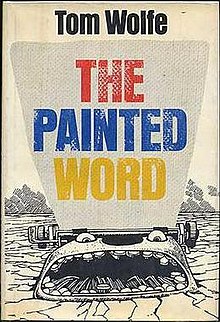
Two, my companion mentioned Tom Wolfes famous critique The Painted Word, a work unknown to me. His reference and corresponding relay of the work’s implication made me feel uninformed, uncomfortable. I think of myself of having an informed appreciation. In that moment his comments challenged both my sensibilities and self-confidence in what I know as it informs my preferences. Ouch!
“Wolfe’s language is revealing. His frenzied prose is effective. Repetition, assonance and alliteration impel language into generalized meaning. The specific is not heard, only a sound—and the sound of The Painted Word combines the tones of propaganda with the promises of religious conversion.”
Though I know of Tom Wolfe’s published work, I’ve only read BonFire of the Vanities and wasn’t mesmerized.
In addition, I was reminded that Wolfe aroused controversy in almost everything he wrote. In searching for The painted Word, I found an ArtNews reprint of Judith Golding’s 1975 book review of Wolfe’s art world critique.
Golding’s read of Wolfe, illustrates something a colleague, Jim McGee recently brought to my awareness that I now realize explains my discomfort with my own poor organization of my acquired knowledge. The generalized meaning of things is hard to attribute and thus difficult to separate from belief. Not everything we know is stable.
What is a label an assigned identity and/or category. How is the manner or state of something, it can also describe a process or development. The why–the inspiration or cause that results in something or someone’s observed manner or state may not always be clear nor is it necessary to know.
Generalized meaning, or general comprehension turn out to be critical building blocks of further knowledge and yet I’m not alone in my failure to actively manage how I build knowledge. So I share Jim’s concern that without managing our knowledge we may miss opportunity to both improve our ability to use and even expand our knowledge.
Coincidentally, according to Golding, Wolfe’s argument with modern art is “based on fear, on the premise that what you don’t know can hurt you.” I can identify with Golding’s frustrations and well illustrated by her provocative prose below.
“Like the audience, Wolfe is bewildered by modern art. “All these years I, like so many others,” Wolfe writes, “had stood in front of a thousand, two thousand, God-knows-how-many thousand Pollocks, de Koonings, Newmans, Nolands, Rothkos . . . waiting, waiting forever for . . . it . . . for it to come into focus, namely, the visual reward (for so much effort) which must be there . . . waiting for something to radiate directly from the paintings. . . .” Wolfe repeats words and stretches out sentences until they engulf the reader. His wait for enlightenment is interminable. And as he waits, the reader waits, feeling the writer’s dilemma, the unbearable angst fo being a philistine, of having tried and failed. The craft of the language might earn a certain respect if Wolfe had succeeded in being either satiric or enlightening. But the message delivered is at best prosaic. Look, he says into the darkness of the readers’ world, you were right all along; you are not missing anything. There is nothing on that blank canvas but blankness.
…Because he reduces concepts to absurdly simple forms, he is understandably attracted to statements which explain complicated or unknown situations and are, therefore, compressed to read with maximum clarity.
ArtNews reprint of Judith Golding’s 1975 book review
Golding complains that Wolfe, the trained journalist, cherrypicks his quotes and even misleads his readers by inserting lines as props in his battle cry against the alchemy of what makes modern art.
In 2020, this same mindless faith as it attaches to much of what we value makes me fearful. Our personal failing to actively manage and curate knowledge drains our power and enables Facebook, Google and Amazon to assume dominant positions as the world’s knowledge brokers.
The esteemed art Critic Steinberg expressed that: “All important art, at least since the Trecento, is preoccupied with self-criticism. Whatever else it may be about, all art is about art. All original art searches its limits. . . .”
Social media and its glib clips, and sloppy clippings of quotes may be a form of curation but falls short of cultivation. Sure there’s process but what is the quality or associated knowledge building advantage? Too often the process is mechanical, the cut and paste with evaluation neglected. Hard to search or push when time and context are in short supply. The result the provocations others easily share erects rather than pushes boundaries of our knowledge.
In the hands of the gifted journalist/author we don’t necessarily get more. Wolfe skillfully reduces concepts to absurdly simple forms. I fear I’m no different in my attraction to statements I sense and/or believe explain complicated or unknown situations. How much can I absorb or assimilate if I too engage with a painted work for the average of less than 3 seconds, or skim the news that’s been compressed for access on my mobile device?
I’m closing with another quote from Golding as I find the metaphor instructive to the challenges of managing the what and how to grow or update my knowledge. Will you join Jim and I on this journey to be our own artists and invent a new order, or at the least begin the dialogue?
“Modern art is unchartable, risky to make and hard to look at. That is why it produces anxiety. But the ultimate value of today’s art is a decision of the future. Art is antithetical to Wolfe’s view of the world. Artists invent a new order.”
If you have ever felt unlucky, or experienced failure, I’m guessing you would still prefer to try something else than ask for help. Admitting to ourselves that we aren’t up to the task happens naturally and presents opportunity. It’s in those moments that control is in your head, and presenting choices. It’s where having a strategy, a young man told me, “creates an edge for future success.”

People regardless of their age or physical health find it impossible to still their thoughts as well as their body. In English, we say people are busy going about their business.
It’s an odd expression when you think about it What business are they doing? Unconsciously, I believe their busy ness keeps them alive–our physical systems are busy processing something—whether it’s breathing, moving, eating, sleeping, digesting and/ or eliminating. Survival is the strategy, even if it’s not conscious.
In Business, survival is also an unconscious strategy, and expansion or growth the conscious description. On a personal level, we are wired for survival. Great businesses build their organizations and support systems consciously by using their edge (or strategy) to align and evaluate the success of their activities and efforts.
If you are among the lucky, your business has more than a plan it has a strategy. What’s the difference? Plans are outputs, while strategy is an active practice, a sign of disciplined thinking at work.
A Business plan merely puts thoughts to paper (or a digital equivalent). The plan isn’t your strategy but evidence that supports your choices, informs your actions. Customers don’t care if you have a plan or a strategy they care whether your business delivers the quality of goods or services that meets their expectations given the price they pay.
Ever play or watch a sport? Think about the relationship of time spent in practice to the quality or caliber of play. A plan to practice differs from assuming the position. What keeps you going, keeps you practicing until your play becomes instinctual self-guided? That’s where having an edge in mind, a strategy keeps guiding your effort, allows you to test slight variations in your movements, coordination, focus, effort and drive.
Strategy is the edge that creates future success. Style and responsiveness differentiate amateur play from professional, they also mark a strategy.
n the heat of play, your best laid plans may go unrealized, but set of moves well-practiced that result from creating a strategy will affect the outcome.


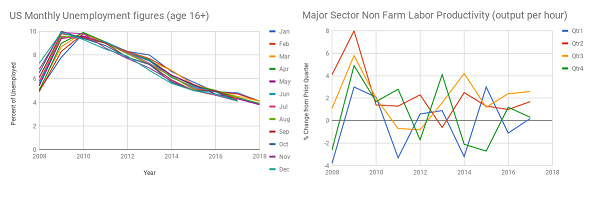
This past week, the U.S. Department of Labor (DOL) issued its May unemployment report of 3.8%, the lowest since April 2000. Yesterday, DOL announced the productivity of nonfarm workers, measured as the output of goods and services for each hour on the job, increased at a 0.4% seasonally adjusted annual rate in the first quarter.
Allegedly, this healthy gain in jobs and the modest gain in wages inspires investors who turn around and buy technology companies. Its why Wall Street Journal writer Michael Wurshoffer, describes technology investments as “a popular trade that contributed to much of the nine-year stock rally’s gains.”
Like any pendulum that swings too far in one direction, eventually, it will reach its limit and then swing back. That’s what typically worries economists and should make others wary too. if you care to think aloud with me, keep reading.
Faster, better, cheaper—increased availability and access to automation achieve all three. These attributes are also shorthand for the means that different business products and services. The challenge is whether automation and digital technology both hybrid proxies also deliver positive business outcomes.
Personally, I’m not so sure and I’m not alone in my doubts.
There are a few wrinkles in this logical string of associations.
Productivity gains are key to companies’ profit margins, and also the key to wider economic growth which is why DOL tracks and reports the statistic. Without margin, business cash flow suffers and investments necessary to build and sustain a business shrink.
This is where hard costs, context, constraints separate the ability of different businesses not just the means of product/service delivery, sales effectiveness but also end-user satisfaction.
Generally, hard or concrete financial measures reflect the relative success of a business. It’s why many businesses evaluate potential opportunity in terms of the potential for return. Will spending on that make us richer? The faster, better, cheaper paradigm is more familiar and the benefits easier to understand than hybrid automation. Technology too often takes special abilities that exceed the internal know-how or resource capabilities.
Opportunity is often in the eye of the beholder, it’s somewhat serendipitous, right? A discovery at the right time, at the right place by capable parties who take and then make an opportunity real and tangible, is rare in the business world, but not in life.
In life, what do you do when you find an object of value lying on the street? Ok, maybe you wonder why it is there; but I’m guessing you feel lucky to find it. In this case, someone else’s loss establishes your opportunity.
In my consulting practice, I am fully conscious and frequently point out to entrepreneurs their strength and unique value proposition derives from their distinct vision. Everyone sees and interprets the world a little differently which is why it’s difficult for others to steal and realize a concept as you envision it.
In business, there’s only a handful of leaders respected for their visions: Steve Jobs and Warren Buffet.
Steve Jobs stands out for his ability to both spot and transform opportunity into tangible value for himself and all of us too. After he spotted the Xerox Parc Graphical User Interface, he managed to shape the ability of others to share his vision, and ultimately create his interpretation.
Note, for him better translated into visual and thus simpler. His legacy company produces products that sustain a loyal fan base willing to pay a premium…so no, not cheaper. Speed? The design and internal integration of functions in all Apple designs make them both easier for users to get what they want, wherever they are and often as they want it. His holistic approach triggered a revolution that we associate with mobility. That combination lifts Apple stock valuations too.
What about Warren Buffet?
Between DOL announcements this week, Wall Street Journal’s Michael Wursthorn reported on value investors–of which Warren Buffet may be the most famous. Wursthorn reported some strategy shifts among value investors as their portfolio performance trails that of growth investors.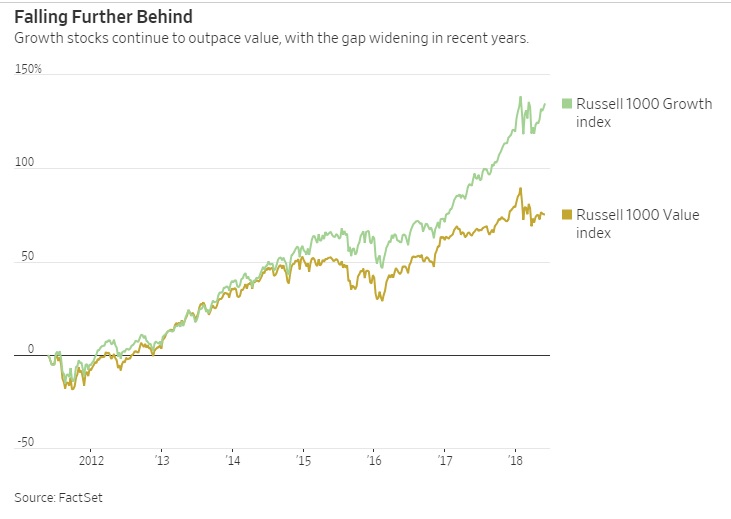
Strategically, I too was intrigued by his observation. Not for the reasons other WSJ readers’ comments pointed out –that value investors buy and hold, which meant several value stocks of yesterday are the growth stocks of today. Apple is one of them.
The definitional debate aside, I focused on the comparative analyses Wursthorn shared and deeper questions than those probed in the article. It seems that the nine-year rally in US stocks excludes Value stocks –a distinction traditionally linked to shares of consumer-staples companies, basic materials firms, and big manufacturers, among others.
Again, this week’s market rally, as Wursthorn mentions seems to favor “asset-light technology” companies.
I wondered, why doesn’t the automation we associate with advancing tools and systems for data processing match the impact of automation we associate with the aforementioned value companies?
My ongoing research on advancing technology and automation made me aware that unlike start-ups, established firms are much slower to invest in advancing digital connectivity especially internally across functions. Is that dragging down their growth relative to other firms more nimbly enabled?
The value sectors historically associated with leveraging hard assets benefit from financial levers that data-rich firms and their soft assets can’t utilize, e.g. securitization. So why are technology firms experiencing dramatic growth and advancing capabilities managing those soft assets by creating more convenient access and delivery of information to their users.
Notice I didn’t mention productivity, and I don’t know how worker productivity between the two types of firms compare.
I do know that digital transformations are closing lots of process gaps. They accelerate both the review and interpretation of data and advance the flow of information to reach the right party in real time.
There’s an art to understanding “use” timetables for different information requests. Just as there’s an art to differentiating wanted from needed information, and the degree price, trust, and safety factor into a buyer’s value equation.
Does the artistry translate into an intrinsic value that an investor would be able to recognize and leverage?
I read with great interest a piece by Chad Syverson, an economist at University of Chicago’s Booth School of business entitled Why hasn’t technology sped productivity? His analysis challenges the traditional constructs and associations that drive value and growth. He writes:
“Making better things using the same amount of resources, or making the same things using fewer resources, is, in the end, where economic growth comes from. If this phenomenon is taking place, you should see it in the data reflected as productivity growth. The problem is, if you go look for it in the United States, you don’t find it.”
His analysis also points out how productivity growth has been elusive for considerably longer than the observation window Wursthorn shared in the Wall Street Journal this past week. Instead, Syverson notes the role played by the diffusion of technology I mentioned earlier. Geoffrey Moore’s Crossing the Chasm differentiates the phases of adoption and their effects on invested capital returns too.
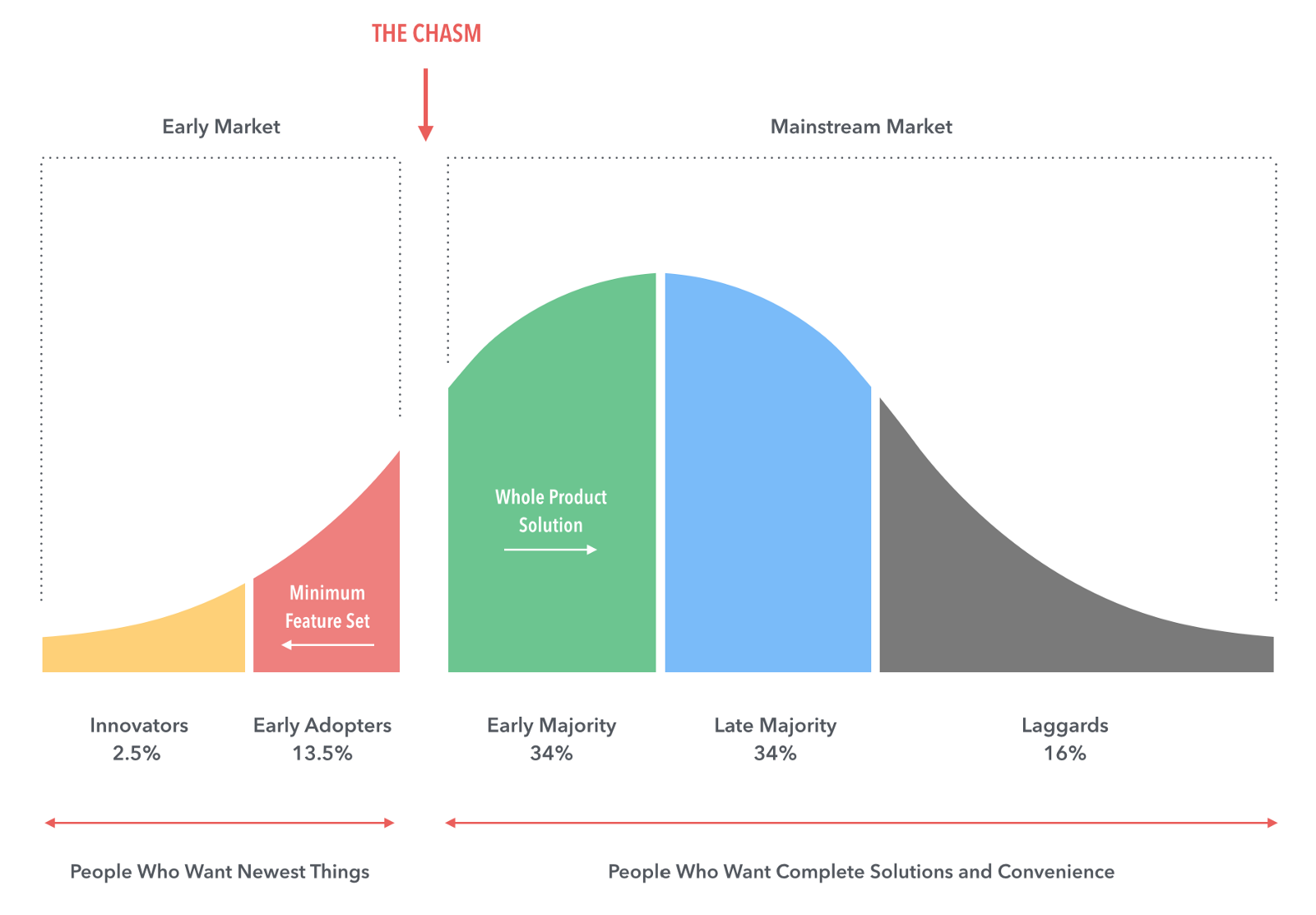
Now, you can appreciate how Warren Buffet, the quintessential value investor didn’t see any signs of value he would recognize. His cash pile estimated to be about $110 billion gives him greater flexibility to put the money to work but only if he and his partner spot it. For example, fundamental investor theory doesn’t value Amazon’s capabilities to disrupt the wider retail market. So this company escaped his notice, to which he explained: “I was too dumb to realize what was going to happen,” he said.
It’s actually understandable for a traditional investor using accounting principles to evaluate an opportunity to overlook the newer forms in which value is created. Until recently, few companies data assets were capable of driving outsized growth. And don’t forget, data holdings remain footnotes not assets on balance sheets.
As a researcher and advisor, my job is to find opportunity but also justify its investment value. It’s why I encourage you to notice the methods and sources of data that academics and journalists evaluate, and what is possible for you to collect, acquire and combine. These methods of analysis, interconnected automation processes, and sources of data also differentiate digital economy leaders from laggards.

Take a moment to picture decision-makers assembled in a board room. The data generated, repackaged as information and presented likely resembles the charts printed in the WSJ and the Chicago Booth Magazine. It also varies dramatically from what a retail sales associate needs to process, or an executive landing at the airport in a city they’ve never been where the language and customs are completely foreign.
Oddly, the unity of experience and shared behaviors of each of these individuals when they touch and access the most ubiquitous automation assistant prejudices each of their expectations. Apple’s recent announcement of the FALL iOS release focuses on enhancing the personal experience and further adoption of productivity applications that compress steps and further simplify adoption and use. Are these same journeys part of the strategic vision or neglected by CEOs.
The separation of technology to support functional activities in an organization competes with the personal behaviors enabled by mobile technologies. As Syverson points out the diffusion of new technology within an enterprise slows productivity and its benefits come in multiple waves.
He hopes to see another retrenchment. I’m hopeful too, that organizational productivity will follow the behaviors and experiences using consumer technologies begin to spread across multiple functions at work. Remember the difference between the specific and deep domain knowledge of these technologies doesn’t come close to the rapidity humans adapt and more importantly learn.

I blew it. I broke my first rule and failed to control my ego.
Not sure what the lovely woman I met at my 35th graduate school class reunion felt, but I’m certain she hadn’t expected the slight and unfiltered commentary that poured out of my mouth.
In my haste to catch up with my classmates, I spotted one across the room standing in a small circle. Had I interrupted an earlier conversation? I’m guessing that’s why this stranger to me raised the topic, that brought out my less admirable qualities.
This very poised and polished woman expressed her enthusiasm for a storytelling webinar she had heard. Coincidentally, I too had participated in the same webinar.
The mistake was my response to her comments in which I undid any credibility I hoped or once had. I blundered in, may have even tossed my head and rolled my eyes expressing annoyance. of course, I can’t really explain what happened or why. For example, I’m guessing that I behaved and acted badly to someone’s eagerness to “learn” how to tell stories–the most natural of human behaviors.
Now in the quiet of my home, the emotions calm, the memory distant, the source of my annoyance is clearer to me.
I’ll admit, I’m lazy when it comes to learning. It’s considerably less work, requires less effort when I ask someone else to tell me the key ideas that will make me successful.
It’s probably why I had bothered to sign up for the storytelling webinar IDEO offered. And it’s probably why I was so bothered that IDEO had attracted an even wider audience of participants.
When we ask someone else to give us the gist or spare us from sifting, sorting and working out what’s important, we take the magic beans approach to learning. 
The magic beans reference is to a fairy tale in which Jack, the main character, is framed as a fool. Why would I mention a fool’s tale?
Don’t worry if you don’t recall the fairy tale, because the story is only a device to help you remember the message. I assume, like me, you too take pride in what you know.
Take a moment. Think about the effort, time and attempts you spend acquiring knowledge that pleases you and makes you proud.
By chance, if you’ve got a recorder nearby play along for a moment. Or open the audio or video application on your phone and hit record.
“Repeat after me.”
“Do what I do.”
Let me be clear, I’ve given you an instruction and now your ability plus your will needs to work out a response. That last bit, the work out? It mixes conscious and unconscious processes. It coordinates the central nervous system receptors and transmitters that pass on the fight/flight triggers that route, interpret, select and cue whatever you do.
Your decision, answer or activity turns out to be a reactive bundle that rapidly assembled in response to my instructions.
STOP RECORDING
Watch/and or listen to your recording.
Were the phrases the same? what differences, if any did you notice?
I presume that you too are calm reading what I’ve written. Do you know the reason I asked you to record this little activity and ask you to compare them? I’m guessing you are also still wondering how any of this relates to magic beans, bonus points if you are beginning to connect all these little messages together.
Congratulations if you are aware of the following:
Back to the real world
with respect to my own failure, and the story I mentioned at the onset of this post, I now get to the purpose and intention behind this posting.
Personally, I spend more time thinking and less time doing. To think through a problem or even identify its root cause requires different skills than applying the fresh thinking or even deeper understanding. True, situations and circumstances vary. Social factors, in particular, affect our behavior often ahead of our awareness.
In my social scenario, I reacted emotionally with little or no thought, intention or consideration for others in my presence. When this happens, I’m less clear and much less effective as I’m reacting to a narrow set of cues. Of course, this is a considerable improvement over my previous habit of interrupting people before they finished telling me anything.
When does my intention to know differ from my hunger for magic beans? Our behaviors give us away. What blew my ego’s cover, was my belief that I knew more than what was being said and I was impatient enough to prove it.
What I didn’t do was practice active listening, use my knowledge to ask questions and honor what others may or may not know. Magic beans are always worth less than you pay for them unless you exercise a little critical thinking.
Earlier I gave you some simple instructions and then used more than the three instructional words to explain what I was doing. What informed my purpose, my intention and lent credibility to make you consent and participate?
The only way to test what you know is to repeat it, think and then write it out. It’s why the teacher in me knows that I’ll be better after I’ve had the chance to think things through. When I just start talking I’m thinking outloud. In some situations that’s appropriate, as in when you want to collaborate. But if people cut you off, then chances are your learning or recitation isn’t worth much.
The best way to apply what I know is to practice and test it, not by giving a lecture but by applying the learning in a demonstration of its meaning.
What about you, do you have any suggestions or ideas for how I can get out of my own way, be open to more possibilities?
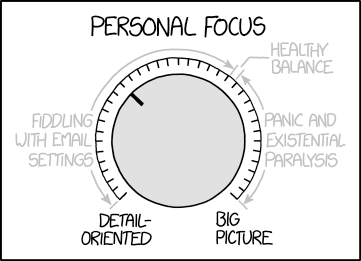
How am I doing? That nagging question arises only in very limited situations where our performance means something personally.
Randall Munroe’s XKCD humor aside, when it comes to focus point of view matters.
People don’t always consciously choose, or control the quantity of effort and attention they willingly apply to a task. The results consequently vary in quality, elapsed clock-time and obviously cost. If you’ve ever lost time and perspective and found yourself completely absorbed and intently focused on a task, use that as one reference point.
Did you work at it? Does measuring your performance on the task matter, or just the results and the experience?
Task managers may activate someone to work but few engage the individual’s energy and commitment to quality acheieved by successful game makers and psychologists who study motivation. Dan Pink in his book Drive, explains why differentiating the task is as important as differentiating the incentives. He goes on to explain that hgh performance connects to something other than rewards which proves difficult for organizations who need to harness individual’s efforts in service of its goals.
Thankfully it’s 2018, and the opportunities for businesses who spend the time and effort to reorganize and separate the meaningless from the meaningful tasks gain considerable advantage.
These organizations harness technology to speed and standardize processes while being mindful of people’s desire to do well. In Manufacturing, Toyota Production Systems and Lean Methods proven adaptability led many industries to embrace this management philosophy, and miss its strategic imperatives that require three to five years in order to produce the lifestyle change that deliver results.
It’s not enough to merely measure performance and seek improvement, both must also represent tangible, meaningful values.
Feeding the desire of individuals to do well unfortunately competes with a firm’s desire to be efficient and effective. It’s easy to confuse the meaning behind psychologist, and pioneer in organizational development Kurt Lewin’s suggestion.
“If you want people to do something, make it easy for them to achieve their goals….”
Management workflow designs that narrow the set of tasks, or reduce the steps do minimize errors and promote consistency. Add in “idiot proof” design of automation and interconnected technologies will make tasks more convenient and tools easy to use–the digital tools include just in time support pop-ups. The efficiency gains acheived by eliminating choices and inadvertently spare people’s attention to the task and thus rob people of finding meaning in their effort.
 Pal’s a fast food company founded in 1956 in northeastern Tennessee does this too but with the employee’s point of view and objectives in mind. Unlike their quick service peers, Pal’s generates $1,800 in sales-per-square foot annually, versus McDonald’s which typically generates less than $650 of annual sales per square foot. These are the figures and full story that William Taylor tells in Simply Brilliant (2016).
Pal’s a fast food company founded in 1956 in northeastern Tennessee does this too but with the employee’s point of view and objectives in mind. Unlike their quick service peers, Pal’s generates $1,800 in sales-per-square foot annually, versus McDonald’s which typically generates less than $650 of annual sales per square foot. These are the figures and full story that William Taylor tells in Simply Brilliant (2016).
Taylor describes the Pal’s management choices through the lens of experience. I sense that Pal’s leadership team interpretation of Lewin’s message as harnessing the contagion power of experience. Walt Disney translated the message at another level that focused on the reason we repeat any experience.
Experiences range in quality and quantity, which is what makes Pal’s remarkable and its success a positive outlier. Pal’s intrigues Taylor not because of its impressive bottom line results, but for “the level of intelligence and intensity with which it approaches everything it does—how it hires, how it trains, how it shares its ideas with other companies eager to learn from its success.”
There’s nothing unusual in that description. Special hiring, training processes, or sharing their approach with other companies sounds just like the other successful high experience focused firms– McDonald’s, Zappos, Disney.
The Pal’s difference is their high bar, the “Triple 100—100 percent execution 100 percent of the time, even when restaurants are operating at 100 percent of capacity.” The point of view built into their mindsight focuses on making employees successful, by holding the leaders and managers who trained them accountable. Pal’s teaches and coaches every day because growth isn’t just about market it’s about people and leadership development.
They hire and guarantee the success of people who want to learn, and employees stick around. They don’t stick around for the high wages or a pension. They stick around for the shared learning, opportunities for personal growth and the pride in being consistently excellent.
Organizations, after all are made up of people. For the near future their success will depend on their ability tap the human need to do well, and offer individuals personal room to grow, continuous support to learn and power to create. Competency depends on circumstance as much as attitude. Ask any high performer and you’ll dscover they still practice and find ways to improve. So why don’t more organizations invest for that level of success?
Dear Jeff, Jamie and Warren
We haven’t met, but each of you express a candor that suggests you are open to informal input.

Naturally, I was not alone in my surprise over your companies- JPMorgan Chase, Berkshire Hathaway and Amazon announced plan to enter the healthcare marketplace. The cover story I saw, explained your unified commitment to contain, if not reduce employee healthcare costs, without mentioning any specifics.
My first thought was perhaps this was a prelude to a presidential bid. The announcement’s bold leadership play has garnered great public enthusiasm. My second thought recognized the power vacuum that followed the failure of the national government to make change. Your united commitment, and unspoken appeal for other CEOs to join you could create further momentum for market driven change.
These thoughts still didn’t feel quite right. I remain optimistic and root loudly for other change agents to shift the tide. As we all know, the challenge to deliver healthy outcomes and affordable healthcare for all are not one dimensional. The complicated systems presently in place fail to address the larger complex inter-relationships between community and individual health.
Have you read David Freedman’s recent assessment of US healthcare system conundrum? It’s not that long, and should be a required read for every team contemplating entering this space. He writes
“It’s easy to think of “health” as just another category of social-service spending. But a great deal of modern research suggests that it might be more accurate to think of it as the payoff of all the other services put together.
I do hope this announcement, in spite of subsequent commentary suggesting otherwise, that your three musketeer esprit de corp adds up to more than a pure group purchase power play. Elizabeth Rosenthal commentary in the NYTimes explains
“Together, these three behemoth corporations will be able to wrest great deals and discounts in their negotiations from hospital systems, drug manufacturers, medical device makers and doctors’ groups.”
OK, it’s why I’m asking you to widen your goal. Don’t settle for negotiating a better deal than what present healthcare arrangements are able to wrangle.
To Jeff, I wondered why you sought out Jamie and Warren to play in an arena internally Amazon team’s have been working, and compromise your reputation and general industry slaying capacity? Amazon’s platform successfully delivers efficiency and value to end users. Are you suddenly squeamish about squeezing healthcare providers and yes, your employees too? Scott Galloway, the NYU Stern faculty describes in The Four your outsized vision has long exceeded the pure e-commerce play that is Amazon today. Galloway further empathizes your tireless advocacy for technology touched by realism about automation’s impact and downstream effect on wages.
These last points makes Jamie a strange bedfellow, as the banking business depends on individuals’ with incomes. But that’s a different letter and article. Jamie, under your leadership JP Morgan Chase offers expertise in compliance, as well as payments and savings that can create some cost saving synergies in Healthcare. More importantly, both industries service and needs are intensely local and subject to state regulations. The consolidations in both banking and healthcare had to rethink bricks and mortar location and staffing. Increasingly, financial services delivery via un-staffed, self-standing kiosks/ATMs and/or rely on mobile enabled applications. Banks, relative to healthcare, historically leveraged technology savvy to fuel growth balance risk and reward effectively and efficiently. Jamie your investments and innovation, though slow starting, and less evenly distributed across the investment, consumer and commercial bank–they do suggest you can leverage the to deliver greater opportunities and create value in Healthcare.
Warren, I’m also hoping these are a few of the elements of value you spotted too. Again, several closer observers of your group planning reiterate that limiting your collective primary intention to lowering employee healthcare costs, reduces the life value of the proposal. That shortsighted objective is certainly not likely to deliver the return on investment necessary to make a dent. I’m counting on you Warren, and your experiences creating larger and profitable opportunities from reorganization.
I’m equally certain you all noticed the dramatic rise of Net Income among healthcare insurers. If you haven’t finished a deeper analysis, start with this one by the Leavitt group that reveals a more complex picture. “[I]nsurers made money in the Medicare, Medicaid and group health insurance markets and lost money in the individual market, which is why some of them exited the individual market in many states.”
 As early as 2006, Michael Porter summarizes the strategic dynamics and cost challenges associated with creating quality healthcare outcomes in Redefining Health Care: Creating Value-Based Competition on Results. The environment he describes of dysfunctional competition leads players to “strive not to create value, but to capture more revenue, shift costs, and restrict services.” Porter felt that healthcare lacked discipline and a management and business focus.
As early as 2006, Michael Porter summarizes the strategic dynamics and cost challenges associated with creating quality healthcare outcomes in Redefining Health Care: Creating Value-Based Competition on Results. The environment he describes of dysfunctional competition leads players to “strive not to create value, but to capture more revenue, shift costs, and restrict services.” Porter felt that healthcare lacked discipline and a management and business focus.
Jeff, Jamie and Warren is that your take too?
I don’t know if it was conversations at Davos and chats with deeply knowledgeable wranglers of this problem that inspired you to act.
I’m inspired by data. As the Affordable Care Act continues to make available additional data, it’s possible to learn more about what works.
Since 2006, researchers in both social and medical science enable more models of service and extends understanding of human health at the individual and population level. Much of healthcare activities used population data to allocate resources. Efforts to reduce costs associated with an individual can now take into consideration individuals’ behaviors. Continued use of aggregate process and success measures mask the affects of too many associated care conditions and reactive activities.
There’s a complex relationship among these issues, and how they are translated into interventions and dosage appear to prevent rather than deliver consistent beneficial outcomes. Hilary Hatch the CEO of Vital sign offered this explanation:
“Population health puts people into categories by conditions (diabetes, hypertension, depression), age, lab results and medical billing data. These categories presume their own importance. When in fact, psychosocial, behavioral and environmental factors determine individual health far more. Patient goals, preferences and barriers to care tell us what stands between that patient and better health. Without this data, population health efforts are undermined.
The explosion of personal health monitoring devices correspond with more data that contribute to advancing understanding of the workings of the human body. Another entrepreneur, Mario Schlosser recognized that “no entity in healthcare has enough data visibility to help you[individuals] navigate the system.”
Is this your collective aspiration too?
A few weeks ago, I attended a presentation at Chicago Booth’s Rustandy Center by the Chief Medical officer for Oak Street Health, Griffin Myers This new medical group does not serve everyone, but the patient population they do serve have consistently better outcomes. The business model that Oak Street Health adopted throws out the traditional fee for service model insurers favor. Instead they get paid when they deliver services that work, the successful outcomes embodied by Accountable Care Organizations as specified in the Affordable Care Act. Oak Street established a value-based care delivery model exclusively serving Medicare (and Medicaid dual-eligible) patients in low income areas. They presently operate 24 clinics across Illinois, Indiana, and Michigan.
This intereview with Griffin Myers on Tasty Trade gives a great overview
Another alternative model of care that should inspire the three of you is Oscar Health, whose estimated valuation of $2.7billion, and claims to be the first technology-based insurance company. Mario Schlosser, an immigrant from Germany realized before the birth of his first child an opportunity to put his own special skills as a data scientist to work. His first hand experience navigating the complexity of the healthcare system led him create Oscar Health in 2012. The company “uses data and product design to guide you through your health care and get you healthy.” As of Oct 2017, he has raised over $720 million and delivers over 100,000 patients concierge style team care in New York, New Jersey, San Francisco, Cleveland, Nashville, Austin, San Antonio, LA and Orange County. Note, many of these cities feature innovative health care service providers but boast a volume of technology talent too.
This interview with Mario on Techcrunch Disrupt in 2017 is a good overview.
Both these approaches recognize that healthcare requires high touch, and a constellation of services to produce the desired outcome. Both of these innovative for profit companies are heavily invested in use of data and technology.
So Jeff, Jamie and Warren under your leadership, will you be equally committed to facilitating connections between traditional care givers, services and systems or just cut out the human to human touch?
Whatever you do, it will be interesting and I’d be happy to help.
Whenever I push or pull too hard, move too fast, or pour out too much of something, I recall my mother cautioning “that’s enough.” Her words remind me “a little goes a long way.”
The reminder, you can imagine, wasn’t always welcome though it was often needed and useful. It’s easy to find ourselves overdoing something, and that includes overthinking too.
Few people relish the experience of others questioning their judgment, or their competency challenged.
Oddly, very successful people do. Bby soliciting helpful input frequently, they gain new perspectives and often advantage. Their success reflects efficiency and effectiveness made possible from others’ perceptions, understanding and experience in precision and quality .
Ever find yourself picking up the wrong impression,mis-understanding directions, or losing valuable time and energy believing you discovered a shortcut others missed for good reasons? Worse, ever find yourself having to redo something because the task was poorly defined, or inappropriate for the situation?
Getting clarity
It’s simple to turn a reactive approach into a proactive plan.
Taking a moment to repeat what you heard, request and then follow up with a statement of the steps you intend to take often spares everyone disappointment. Replace the knee jerk why questions in your head with clear, positively stated responses both convey what you understand and assure the requester satisfaction of their needs.
It’s simple, and yet the extra moments to pause, don’t trigger an active assumption check. In thinking through what’s next we too often skip over the evidence or clarify our own understanding.
“Did I get that right?”
Successful people ask questions with confidence because they value their time, and also believe others do too!